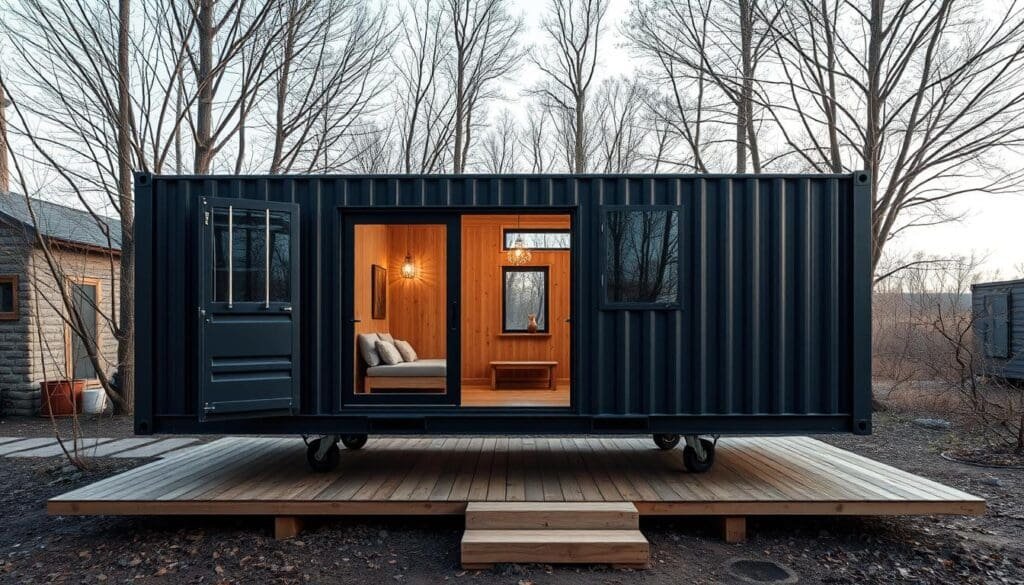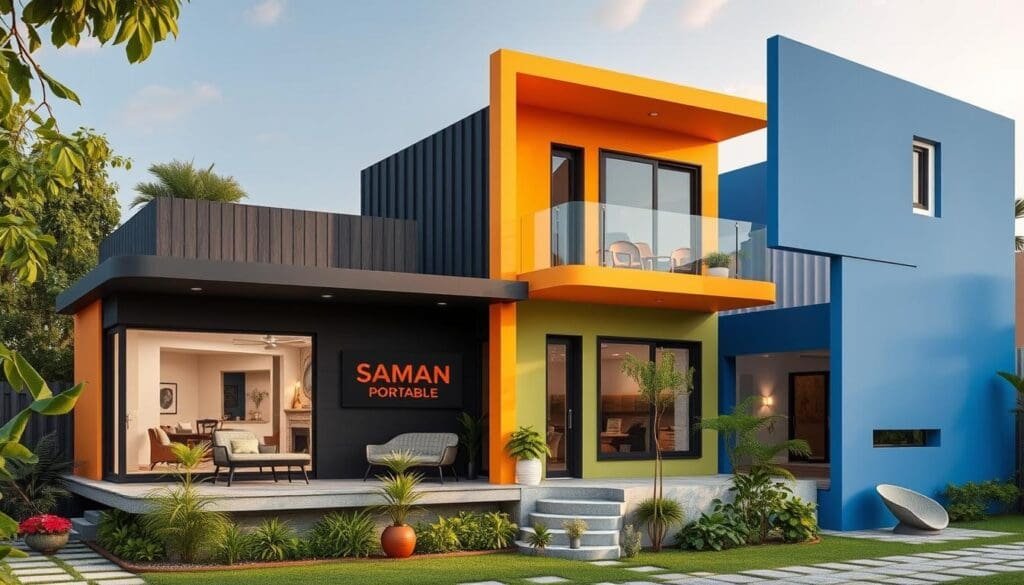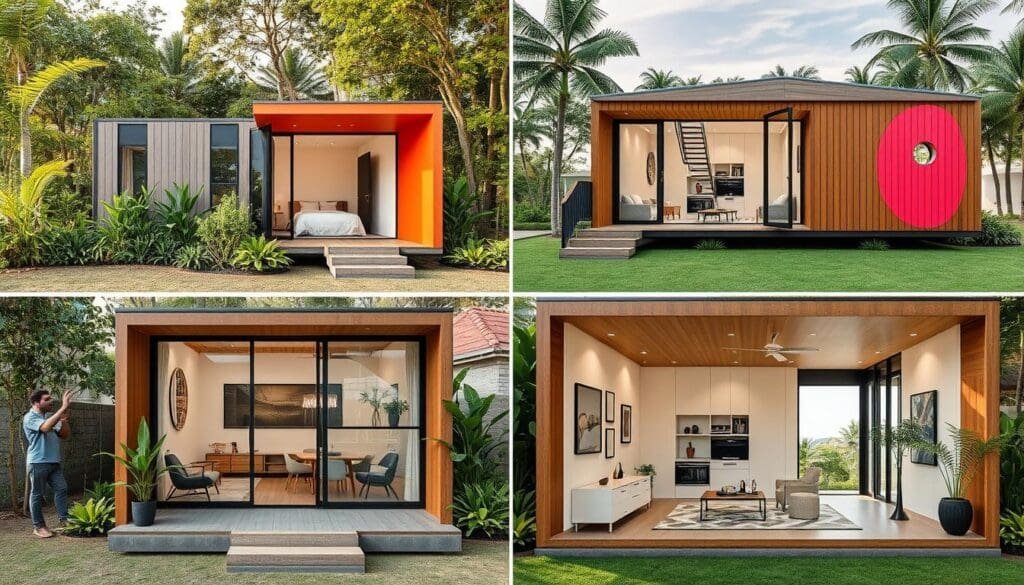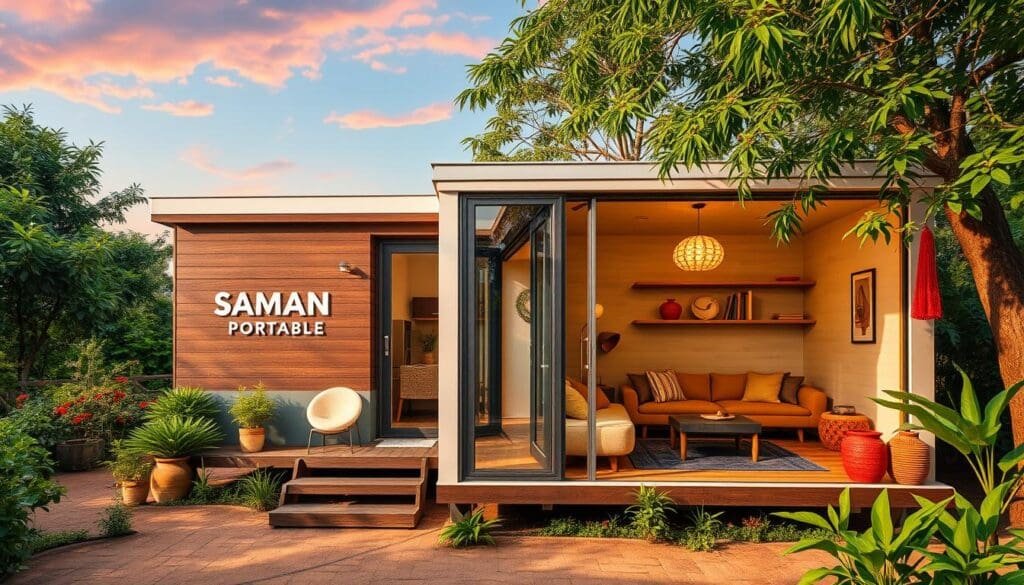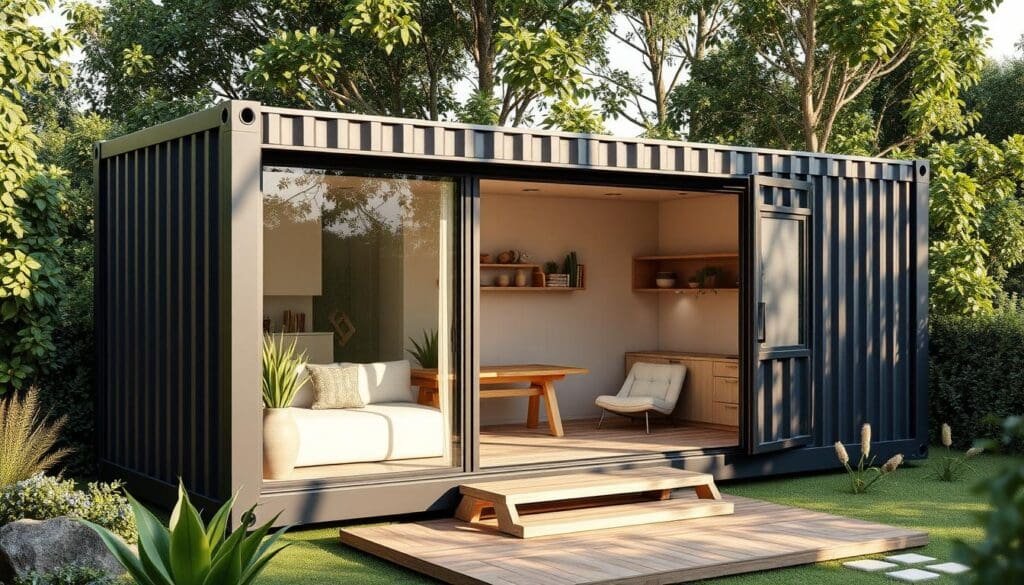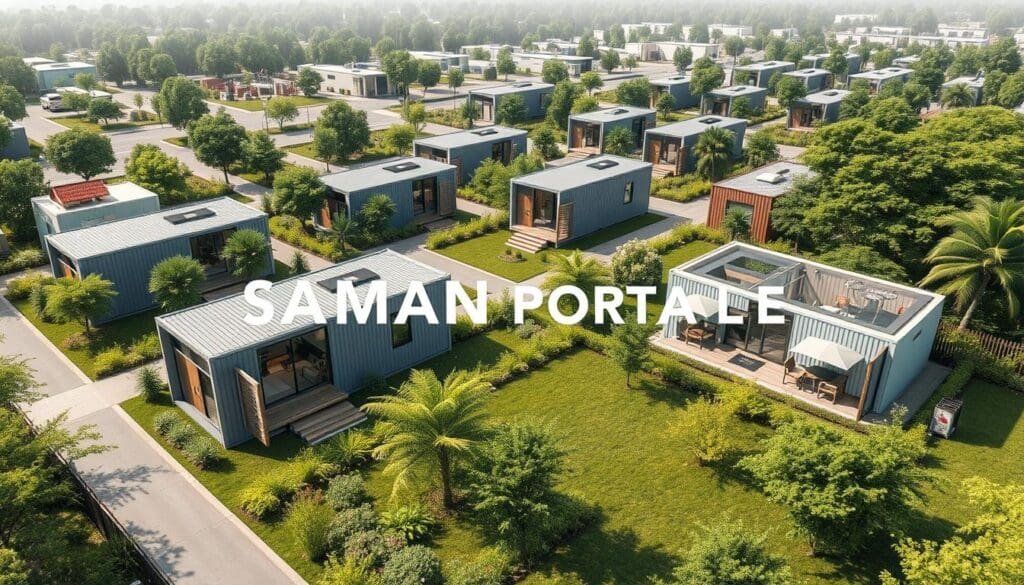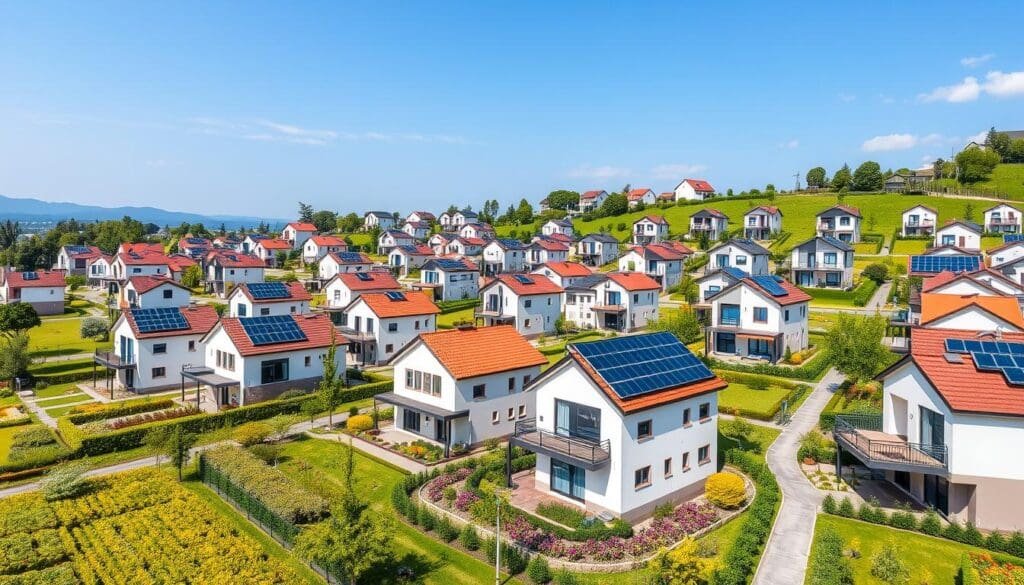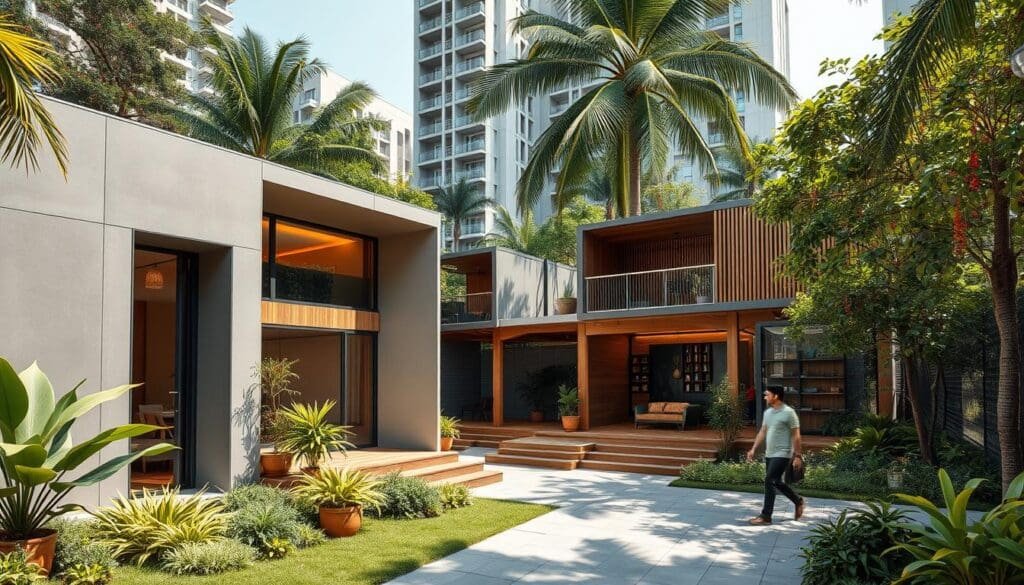Containerized Housing: The Ultimate Modular Solution for Sustainable Living
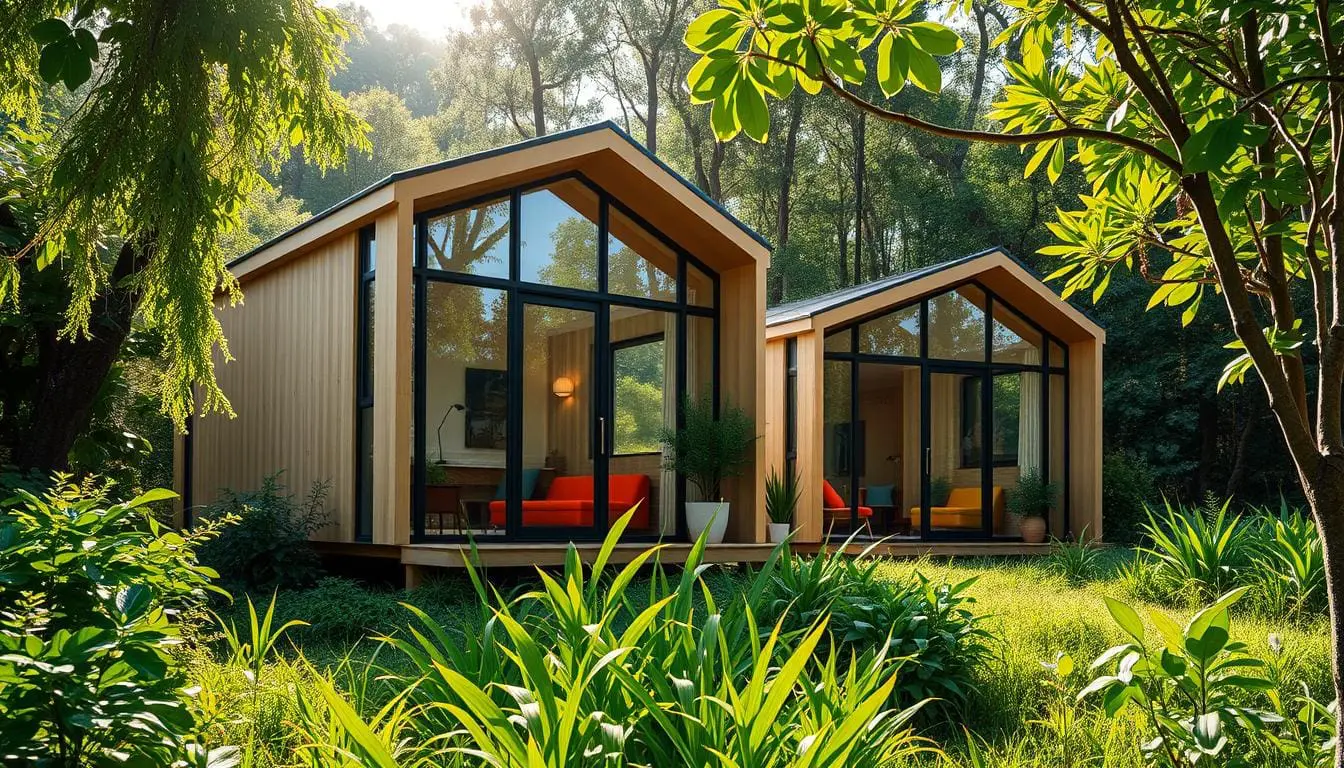
Repurposed shipping containers are changing modern architecture. They offer a smart, affordable, and green housing option. In fact, they can be 50% cheaper than regular houses, thanks to lower building and upkeep costs.
These modular homes are strong and can handle tough weather. They come with the basics like electricity, plumbing, and heat. Plus, they’re customizable to fit your style and needs.
Using recycled containers and energy-saving systems cuts down on carbon emissions and bills. This makes them a green choice for homes. Their design also means they can be moved or grown, perfect for short-term or semi-permanent stays.
Key Takeaways
- Container modular living quarters are cost-effective compared to traditional houses due to reduced construction and maintenance costs.
- The use of recycled shipping containers and energy-efficient systems helps reduce carbon footprint and utility bills.
- Container homes offer customization options in terms of floor plans, finishes, fixtures, and appliances.
- The modular design allows for easy relocation or expansion, making them suitable for temporary or semi-permanent housing.
- Container modular homes are an innovative and eco-friendly housing solution that is both sustainable and stylish.
Understanding the Rise of Container Homes in Modern Architecture
Container homes are becoming a big deal in modern architecture. They are loved for being eco-friendly and affordable. These homes are strong, flexible, and good for the planet. They meet the need for homes that are cheap, adaptable, and green.
Evolution of Shipping Container Architecture
The idea of using shipping containers as homes started in the mid-20th century. Pioneers like Buckminster Fuller and Yona Friedman saw the potential for modular, portable homes. The Proxy project in San Francisco shows how shipping containers can be used today, housing outdoor businesses.
Key Benefits of Container Housing Solutions
- Design Customization: Container homes can be made to fit your exact needs and style.
- Potential for Off-Grid Living: They can be built to use less energy and work without the usual utilities, perfect for a green lifestyle.
- Resilience against Environmental Conditions: Their strong, weatherproof design keeps them safe from harsh weather.
Market Growth and Industry Trends
The demand for container homes is rising fast. This is because they are cheap and can be changed to fit different needs. If recycled, one container can make enough steel for 14 houses, showing their potential for green building. Texas, California, and Oregon are at the forefront, with their rules and success stories.

The Environmental Impact of Container Home Construction
Sustainable living and eco-friendly building or construction are key in today’s architecture. Container homes offer a solution by using shipping containers. This reduces waste that would otherwise go to landfills or oceans.
Container homes help the environment by using less new materials. The steel in containers lasts longer, needing fewer repairs. This cuts down on waste over time. Plus, they use space wisely, making homes more efficient.
| Sustainable Advantage | Traditional Construction | Container Homes |
|---|---|---|
| Building Materials | Wood frame construction typically uses 2″ x 4″ dimensional lumber, contributing to high material consumption. | Shipping containers are repurposed, reducing the demand for new building materials and minimizing construction waste. |
| Construction Time | Traditional on-site construction can take weeks to complete a new home. | Container homes can be assembled more efficiently, reducing the overall construction timeline. |
| Long-term Maintenance | Ongoing maintenance and repairs are necessary for traditional homes. | Shipping container homes require minimal maintenance if painted with industrial paint, reducing long-term costs and environmental impact. |
Choosing container homes supports a greener future. It also brings practical benefits to individuals and communities.

Cost-Effectiveness: Breaking Down the Financial Benefits
For many homeowners, affordability is key. Affordable Housing and Cost-effective Modular Construction are where shipping container homes shine. They offer big financial pluses, making them a smart choice for those looking to save money.
Initial Investment vs Traditional Housing
Getting a shipping container home costs less than a traditional house. New containers cost between $3,000 and $5,000. Used ones start at $1,200. Plus, building a container home is quicker and cheaper, with costs from $25,000 to $150,000 or more.
Long-term Maintenance Costs
Shipping container homes are also cheaper to keep up over time. Their steel structure needs little care, and they use less energy. This means lower bills and upkeep costs, making them a smart, eco-friendly choice.
Return on Investment Potential
Shipping container homes are also great for making money later. You can add to or change them as needed. As more people want them, their value and resale price might go up, giving you more financial gains.
Design Flexibility and Customization Options
Modular design is key in container homes, offering great flexibility and customization. Standard 20-foot (160 square feet) and 40-foot (320 square feet) shipping containers have big interiors. This allows for creative floor plans and layouts.
Homeowners can pick from many finishes, fixtures, and appliances. This helps create living spaces that match their personal taste.
The modular design of Modular Design makes it easy to change or add to Custom Container Homes as needed. Containers can be stacked, combined, and modified. This allows for multi-story structures, open-concept designs, or special areas like home offices or guest quarters.
| Customization Options | Benefits |
|---|---|
| Flexible Floor Plans | Tailored living spaces to suit individual needs |
| Variety of Finishes | Personalize the aesthetic with unique styles and materials |
| Modular Expansion | Adapt to changing requirements over time |
| Multi-Story Configurations | Maximize limited land space with vertical construction |
The versatility of Modular Design and the customization options of Custom Container Homes make them a great choice. They offer unique, personalized living solutions. By using shipping containers, homeowners can build their dream homes affordably and sustainably.

Containerized Housing: A Sustainable Living Solution
The world is moving towards green living and sustainable architecture. Containerized housing is becoming a popular choice. These homes are made from old shipping containers. They show how to build homes that are good for the planet and use resources wisely.
Energy Efficiency Features
Containerized homes are built to save energy. This helps the environment and saves money. They come with features like:
- High-performance insulation to keep temperatures right all year
- Solar panels to make electricity from the sun
- Rainwater harvesting to use water for home needs
Eco-friendly Materials and Construction
Building containerized homes means using old shipping containers. This cuts down on waste and saves resources. The steel is then made into homes with green touches, like:
- Sustainable wood for walls and furniture
- Recycled materials for insulation and floors
- Windows and doors that save energy
Containerized housing is a great choice for those wanting to live green. It’s modern, comfy, and good for the planet.

Space Optimization and Interior Planning
Tiny house living is all about making the most of small spaces. Container homes are perfect for this, using every inch wisely. They offer smart ways to store things and keep your living area tidy.
Open-concept layouts make these homes feel bigger. You’ll find furniture that folds up and loft spaces to save room. Built-in shelves and cabinets help keep things organized and flowing well.
Lighting is key in container homes. Big windows and glass doors let in lots of natural light. The right mix of lights makes the space bright and welcoming.
Smart design is crucial for container homes. It makes them functional, comfortable, and livable. By using space wisely, you can enjoy a minimalist lifestyle without giving up comfort.

Container homes show how smart design can save space. They use clever storage and lighting to make the most of every inch. These homes are a great choice for those looking for a sustainable, affordable living option.
Structural Integrity and Durability Factors
Shipping containers are known for their toughness. They are great for building strong, weather-resistant homes. These metal boxes can handle the tough conditions of sea travel and lots of handling.
Weather Resistance Properties
Shipping containers are built to resist the weather. Their strong steel and special coatings fight off rust. They can handle strong winds, heavy rain, and even earthquakes.
They also keep out pests, rot, and mold. This means your container home will stay strong for a long time.
Lifespan and Maintenance Requirements
With the right care, container homes can last as long as regular houses. They need less upkeep because their steel doesn’t weather or decay easily. Just check them now and then, and fix any small problems.

The condition of the shipping container matters when you’re making it into a home. Containers that have been used a lot may need more work. Look for big dents or rust to see if it’s okay to modify.
It’s also key to handle and stack containers right. Use cranes or forklifts and make sure they’re locked together safely. This keeps your building stable and safe.
Modern Amenities and Smart Home Integration
Smart Container Homes are changing how we live. They mix the comfort of regular homes with the flexibility of modular ones. These homes come with modern features and smart home tech for a new way of living.
Container Homes have everything from full kitchens to big living areas. They even have luxury bathrooms. But what really sets them apart is the smart home tech. It turns these small homes into High-tech Living Spaces.
- Automated lighting control for optimal energy efficiency and ambiance
- Intuitive climate management systems for precise temperature and humidity regulation
- Advanced security systems with remote monitoring and access control
- Integrated home entertainment systems for seamless multimedia experiences
- Intelligent appliances and voice-activated assistants for enhanced convenience
The small size of Container Homes is perfect for smart home tech. It lets people control and monitor their home easily. This makes living there more efficient, safe, and simple.
| Feature | Benefit |
|---|---|
| Automated Lighting | Energy-efficient illumination with remote control and scheduling |
| Smart Climate Control | Precise temperature and humidity regulation for optimal comfort |
| Integrated Security | Comprehensive monitoring and access control for enhanced safety |
| Connected Appliances | Seamless management and optimization of household devices |
The Container Homes market is growing fast. With more smart home tech, these homes will become the top choice for modern, green, and High-tech Living Spaces.

Legal Considerations and Building Regulations
Building a container home involves understanding legal steps. Zoning laws and building permits are key. Knowing your area’s rules is crucial to avoid problems.
Zoning Laws and Permits
Zoning laws differ by location and affect container home projects. Some places have rules for alternative homes, while others don’t. Getting permits means showing you follow local building codes, even if they’re not made for containers.
Future container home owners should do their homework. They might need to talk to local officials. This ensures they follow all laws and get the right permits for a smooth build.
Building Code Compliance
Building codes are vital for container homes. The IRC and IBC offer guidelines, but local rules can vary. For example, Massachusetts has its own code for container homes, requiring extra work for safety and energy.
Working with experts like architects or contractors is helpful. They can make sure your home meets all the rules. This includes safety and fire standards, protecting everyone involved.

Understanding local laws and codes is essential for a successful container home. Following zoning and building codes makes your home legal and safe. It also ensures your home lasts long and is sustainable.
Transportation and Site Installation Process
The transportation and on-site installation process is a key advantage of Container Home Delivery and On-site Installation solutions. Shipping containers can be easily transported by truck, train, or ship. This makes them highly versatile for delivery to various locations.
For larger container home structures, specialized cranes are used to carefully lift and position the units. Smaller individual containers can be moved using forklifts. This enhances the flexibility of the installation process. Typically, the entire installation can be completed in a matter of days or weeks, significantly faster than traditional construction methods.
The site preparation for a container home is minimal. It generally requires only a flat, level surface to accommodate the structure. This streamlined installation process contributes to the overall cost-effectiveness and adaptability of container home solutions. They are an attractive choice for a wide range of residential and commercial applications.

SAMAN Portable, a leading provider of modular containerized solutions, offers specialized flat-pack containers designed for ease of transport and on-site assembly. These prefabricated units can be quickly and efficiently installed. They provide a turnkey solution for various residential, commercial, and industrial needs.
SAMAN Portable‘s comprehensive support system includes engineering consultancy, design, manufacturing, installation, and after-sales service. They ensure a seamless experience for clients. Whether it’s worker accommodation, emergency housing, or specialized commercial applications, SAMAN Portable‘s innovative containerized solutions offer a versatile and cost-effective approach to modern construction.
Multi-Unit Development and Commercial Applications
Container structures are not just for homes. They’re also used for Container Office Spaces and retail. Plus, they’re great for community housing projects. Containers are easy to add to or expand, making them perfect for any size project.
Office Spaces and Retail Solutions
Shipping containers are great for offices and stores. Companies like SAMAN Portable turn them into modern workspaces. You can stack them to build tall commercial buildings, saving space.
Community Housing Projects
- Container homes are quick and affordable for housing needs or temporary stays.
- The Rosa Parks condo complex in Detroit is the first in the U.S. made from recycled containers. It has 20 units and 26,000 sq. ft.
- A project in Lake Tahoe shows how containers can be used for housing. It has 65 units on 67 acres.
Container structures are changing how we build. They offer new ways to create office spaces, stores, and homes. Their design, durability, and cost make them a smart choice for building.
Climate Control and Insulation Solutions
When designing container homes, it’s key to focus on climate control and insulation. Steel in shipping containers conducts heat well. So, we need smart insulation to keep temperatures right and stop moisture buildup.
There are many insulation materials to choose from. Spray foam, rigid foam boards, and recycled denim are good options. Spray foam, for example, insulates well and also blocks sound. Batt insulation is great for offices and homes, with R-values of 13 or 19.
Ventilation systems are important for air quality and humidity control in container homes. Energy-efficient HVAC units can be added to keep the space comfortable in any weather.
| Insulation Type | R-Value | Lifespan | Key Benefits |
|---|---|---|---|
| Styrofoam | 4 (1-inch thickness) | 50 years | Suitable for basic storage containers |
| Batt Insulation | 13 (3.5-inch thickness), 19 (6-inch thickness) | 100 years | Ideal for container offices and living spaces |
| Spray Foam Insulation | 6 (1-inch thickness), 12 (2-inch thickness), 18 (3-inch thickness) | 80 years | Suitable for temperature-sensitive equipment enclosures |
| Mineral Wool | 13 to 26, depending on application | 100 years | Ideal for spaces requiring non-flammable insulation |
Choosing the right Container Home Insulation and Temperature Control systems is crucial. This way, container home owners can enjoy comfortable, energy-saving living spaces. These spaces can handle different weather conditions well.
Off-Grid Living Possibilities with Container Homes
Container homes are perfect for living off the grid. They are small and use less energy. You can add solar panels, collect rainwater, and use composting toilets.
This setup lets you not rely on the usual power and water sources. You can store energy in batteries for when it’s dark or cloudy.
Shipping containers are strong and easy to adapt. They’re great for places where building is hard. By using them, you cut down on waste and use less new materials.
With the right insulation and climate control, these homes stay cozy. They also use less energy. This makes living off the grid more comfortable and sustainable.
Off-grid container homes are good for the planet and for people who can’t get to regular utilities. They use green energy and save resources. This way, you can live freely, save money, and choose where you want to be.
FAQ
What are the key benefits of containerized housing solutions?
Containerized housing is made from old shipping containers. It’s affordable and good for the planet. These homes are strong and can handle bad weather.
They come with all the basics like electricity and plumbing. You can design them to fit your needs and save money compared to regular houses.
How does containerized housing contribute to environmental sustainability?
Container homes cut down on waste by using old shipping containers. This helps the environment by using less new materials. The steel in containers lasts a long time, needing fewer repairs.
This means less harm to the planet over time. It’s a big step towards saving our environment.
What are the cost-saving benefits of container homes?
Container homes are cheaper to build than regular houses. They cost less upfront and take less time to build. They also need less maintenance because they’re made of strong steel.
You can add more rooms or change things up later. This can make your home more valuable. Plus, they use less energy, which means lower bills.
How flexible are the design options for container homes?
Container homes can be set up in many ways. You can use the space inside to create your dream home. You can pick your own style and add your favorite features.
They’re easy to change or add to as your needs change. This makes them very flexible and adaptable.
How durable and weather-resistant are container homes?
Shipping containers are built to last, even in tough weather. When turned into homes, they keep this strength. They protect against wind, rain, and even earthquakes.
The steel keeps out pests and doesn’t rot or mold. With care, they can last as long as or longer than regular houses.
What are the legal considerations when building container homes?
Building container homes means dealing with laws. Zoning rules can affect where you can build. You’ll need to show your home meets local building codes.
Some places have special rules for these homes. It’s important to check the laws in your area. You might need to talk to local officials to make sure you’re following the rules.
Can container homes be used for commercial applications?
Yes, container homes are great for businesses too. They can be offices, stores, or even community housing. They’re easy to add to or change, making them perfect for growing projects.
They’re a fast and affordable way to solve housing problems or provide temporary homes.
How can container homes be adapted for off-grid living?
Container homes are perfect for living off the grid. They’re small and use less energy. You can add solar panels, collect rainwater, and use composting toilets.
They’re strong enough for hard-to-reach places. Living in one means you can live more sustainably and be less dependent on the grid.
 Container Cafe
Container Cafe
















































































